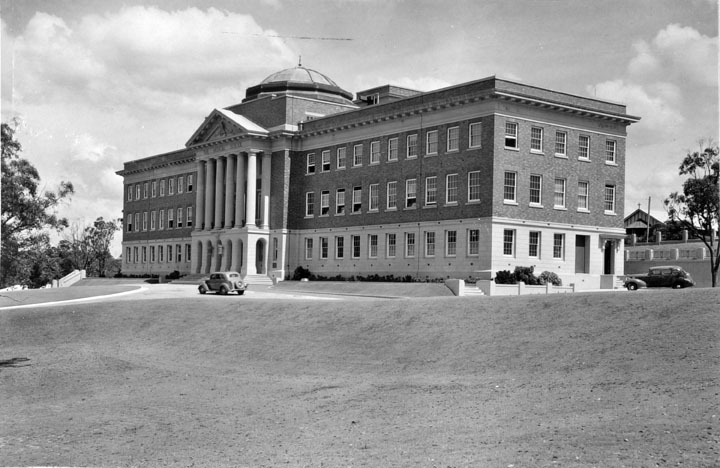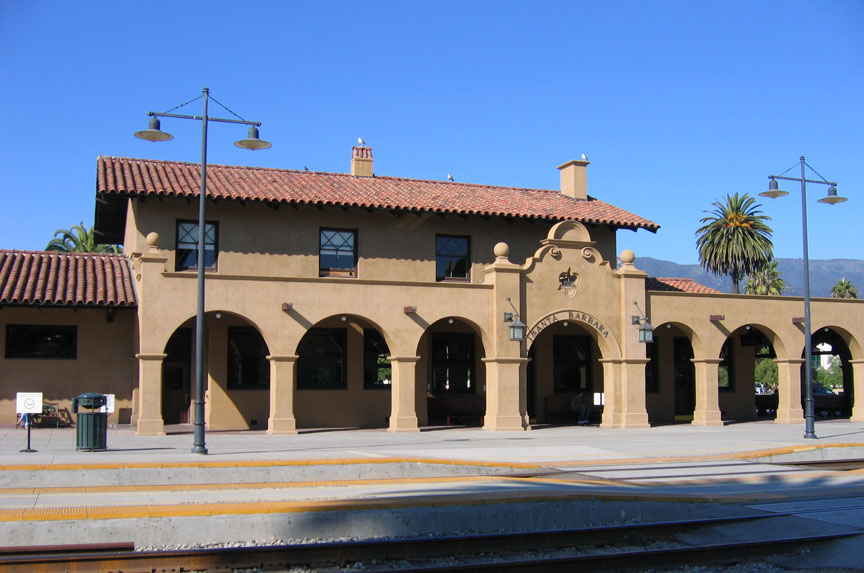|
Newmarket State School
Newmarket State School is a heritage-listed state school at 320 Enoggera Road, Newmarket, Queensland, Newmarket, City of Brisbane, Queensland, Australia. It was designed by Queensland Department of Public Works and Boulton & Paul Ltd and built from 1910 to 1960. It was added to the Queensland Heritage Register on 5 February 2016. History Newmarket State School (established 1904), located in the Brisbane suburb of Newmarket, approximately five kilometres northwest of the Brisbane central business district (CBD), is important in demonstrating the evolution of state education and its associated architecture. It retains an early Great Depression, Depression-era brick school building (1934, extended 1947) and a Boulton & Paul building (1954, extended 1955, 1956) set within landscaped grounds including a playing field, assembly and play areas, paths, and mature trees. The school has a strong and ongoing association with the Newmarket community. By 1900, the Government of Queensland ... [...More Info...] [...Related Items...] OR: [Wikipedia] [Google] [Baidu] |
Newmarket, Queensland
Newmarket is a north-west Suburbs and localities (Australia), suburb in the City of Brisbane, Queensland, Australia. In the , Newmarket had a population of 5,083 people. Geography Newmarket is located approximately by road from the Brisbane CBD. It is an older, mostly residential suburb containing pre-war and post-war homes, including many fine examples of the Queenslander (architecture), Queenslander style of home. Over the last few years, some medium-density townhouses and unit blocks have appeared as well. History Newmarket was originally known as "The Three Mile Scrub" due to its distance from the city, and Ashgrove Avenue, which links Enoggera Road, Brisbane, Enoggera Road with Waterworks Road to the west, was known as Three Mile Scrub Road. As Brisbane continued to grow northward along Kelvin Grove Road, in about 1880 it was decided to relocated Brisbane's livestock saleyards from Normanby, Queensland, Normanby to an outer location, the area now bordered by Enogger ... [...More Info...] [...Related Items...] OR: [Wikipedia] [Google] [Baidu] |
Trams In Brisbane
The Brisbane tramway network served the city of Brisbane, Australia, between 1885 and 1969. It ran on standard gauge track. The electric system was originally energised to 500 volts, and subsequently increased to 600 volts. All tramcars built in Brisbane up to 1938 had an open design. This proved so popular, especially on hot summer nights, that the trams were used as fundraisers and often chartered right up until the last service by social groups. Most trams operated with a two-person crew – a driver (or Motorman (locomotive), motorman) and a conductor, who moved about the tram collecting fares and issuing tickets. The exceptions to this arrangement were on the Gardens line (Lower Edward Street) where the short duration of the trip meant it was more effective for passengers to simply drop their fare into a fare box as they entered the tram; and the "one man cars" which operated in the early 1930s (see #"One man" trams, below). The peak year for patronage was in 1944–45 whe ... [...More Info...] [...Related Items...] OR: [Wikipedia] [Google] [Baidu] |
University Of Queensland Mayne Medical School
University of Queensland Mayne Medical School is a heritage-listed university building at 288 Herston Road, Herston, City of Brisbane, Queensland, Australia. It was designed by Raymond Clare Nowland and built from 1938 to 1939. It is also known as University of Queensland Medical School. It was added to the Queensland Heritage Register on 24 June 1999. The Marks-Hirschfeld Museum of Medical History is located within the building. Operated by volunteers, it has a collection of over 7,000 items of medical memorabilia, medical and surgical instruments. The focus is on the study of medical history in Queensland, but the collection includes items with broader significance to both Australia and internationally. History A monumental, three-storey, red facebrick building in a Renaissance idiom occupying a ridge adjacent to the Royal Brisbane Hospital and overlooking Victoria Park at Herston, the Mayne Medical School was opened by the Premier of Queensland, Hon. William Forgan Smith ... [...More Info...] [...Related Items...] OR: [Wikipedia] [Google] [Baidu] |
Arthur J Moase
Arthur is a masculine given name of uncertain etymology. Its popularity derives from it being the name of the legendary hero King Arthur. A common spelling variant used in many Slavic, Romance, and Germanic languages is Artur. In Spanish and Italian it is Arturo. Etymology The earliest attestation of the name Arthur is in the early 9th century Welsh-Latin text ''Historia Brittonum'', where it refers to a circa 5th century Romano-British general who fought against the invading Saxons, and who later gave rise to the famous King Arthur of medieval legend and literature. A possible earlier mention of the same man is to be found in the epic Welsh poem ''Y Gododdin'' by Aneirin, which some scholars assign to the late 6th century, though this is still a matter of debate and the poem only survives in a late 13th century manuscript entitled the Book of Aneirin. A 9th-century Breton landowner named Arthur witnessed several charters collected in the '' Cartulary of Redon''. The Irish borrow ... [...More Info...] [...Related Items...] OR: [Wikipedia] [Google] [Baidu] |
Neoclassical Architecture
Neoclassical architecture, sometimes referred to as Classical Revival architecture, is an architectural style produced by the Neoclassicism, Neoclassical movement that began in the mid-18th century in Italy, France and Germany. It became one of the most prominent architectural styles in the Western world. The prevailing styles of architecture in most of Europe for the previous two centuries, Renaissance architecture and Baroque architecture, already represented partial revivals of the Classical architecture of Roman architecture, ancient Rome and ancient Greek architecture, but the Neoclassical movement aimed to strip away the excesses of Late Baroque and return to a purer, more complete, and more authentic classical style, adapted to modern purposes. The development of archaeology and published accurate records of surviving classical buildings was crucial in the emergence of Neoclassical architecture. In many countries, there was an initial wave essentially drawing on Roman archi ... [...More Info...] [...Related Items...] OR: [Wikipedia] [Google] [Baidu] |
Spanish Mission Architecture
The Mission Revival style was part of an architectural movement, beginning in the late 19th century, for the revival and reinterpretation of American colonial styles. Mission Revival drew inspiration from the late 18th and early 19th century Spanish missions in California. It is sometimes termed California Mission Revival, particularly when used elsewhere, such as in New Mexico and Texas which have their own unique regional architectural styles. In Australia, the style is known as Spanish Mission. The Mission Revival movement was most popular between 1890 and 1915, in numerous residential, commercial and institutional structures, particularly schools and railroad depots. Influences All of the 21 Franciscan Alta California missions (established 1769–1823), including their chapels and support structures, shared certain design characteristics. These commonalities arose because the Franciscan missionaries all came from the same places of previous service in Spain and colonial ... [...More Info...] [...Related Items...] OR: [Wikipedia] [Google] [Baidu] |
Arts And Crafts Movement
The Arts and Crafts movement was an international trend in the decorative and fine arts that developed earliest and most fully in the British Isles and subsequently spread across the British Empire and to the rest of Europe and America. Initiated in reaction against the perceived impoverishment of the decorative arts and the conditions in which they were produced, the movement flourished in Europe and North America between about 1880 and 1920. Some consider that it is the root of the Modern Style, a British expression of what later came to be called the Art Nouveau movement. Others consider that it is the incarnation of Art Nouveau in England. Others consider Art and Crafts to be in opposition to Art Nouveau. Arts and Crafts indeed criticized Art Nouveau for its use of industrial materials such as iron. In Japan, it emerged in the 1920s as the Mingei movement. It stood for traditional craftsmanship, and often used medieval, romantic, or folk styles of decoration. It advoca ... [...More Info...] [...Related Items...] OR: [Wikipedia] [Google] [Baidu] |
Classical Architecture
Classical architecture typically refers to architecture consciously derived from the principles of Ancient Greek architecture, Greek and Ancient Roman architecture, Roman architecture of classical antiquity, or more specifically, from ''De architectura'' (c. 10 AD) by the Roman architect Vitruvius. Variations of classical architecture have arguably existed since the Carolingian Renaissance, and became especially prominent during the Italian Renaissance and the later period known as neoclassical architecture or Classical revival. While classical styles of architecture can vary, they generally share a common "vocabulary" of decorative and structural elements. Across much of the Western world, classical architectural styles have dominated the history of architecture from the Renaissance until World War II. Classical architecture continues to influence contemporary architects. The term ''classical architecture'' can also refer to any architectural tradition that has evolved to a highl ... [...More Info...] [...Related Items...] OR: [Wikipedia] [Google] [Baidu] |
Department Of Public Works (Queensland)
The Department of Housing and Public Works is a ministerial department within the Queensland Government, tasked with providing housing, sport, digital technology, and urban design and architecture services Both Smart Service Queensland (SSQ) and Queensland Shared Services (QSS) sit within Housing and Public Works, providing whole-of-government services including HR, payroll, procurement, infrastructure, and state-wide contact centre solutions. The department was previously called the Department of Communities, Housing and Digital Economy prior to the November 2024 machinery of government changes. Executive leadership Minister and director-general The various streams within the department are responsible to the Queensland Parliament through the Minister for Housing and Public Works and Minister for Youth. Since 1 November 2024, Sam O’Connor is the Minister for Housing and Public Works and Minister for Youth. Day-to-day operations are led by the department director-general ... [...More Info...] [...Related Items...] OR: [Wikipedia] [Google] [Baidu] |
Great Depression In Australia
Australia was affected badly during the period of the Great Depression of the 1930s. The Depression began with the Wall Street crash of 1929 and rapidly spread worldwide. As in other nations, Australia had years of high unemployment, poverty, low profits, deflation, plunging incomes, and lost opportunities for economic growth and personal advancement. The Australian economy and foreign policy largely rested upon its place as a primary producer within the British Empire, and Australia's important export industries, particularly primary products such as wool and wheat, suffered significantly from the collapse in international demand. Unemployment reached a record high of around 30% in 1932, and gross domestic product declined by 10% between 1929 and 1931. There were also incidents of civil unrest, particularly in Australia's largest city, Sydney. Though Australian Communist and far right movements were active in the Depression, they remained largely on the periphery of Australia ... [...More Info...] [...Related Items...] OR: [Wikipedia] [Google] [Baidu] |
Cannon Hill, Queensland
Cannon Hill is a suburb in the City of Brisbane, Queensland, Australia. In the , Cannon Hill had a population of 6,701 people. Geography The suburb is located by road east of the Brisbane CBD. History Cannon Hill was originally inhabited by Aboriginal people but, after being accused of "intimidating" the settlers, they were "dispersed" by the Native Police and Brisbane Mounted Police in November 1861, around the time when British settlement began in the area. Some land was used by settlers for farming and grazing, but the area remained mostly bushland. The suburb is most likely named after Cannon Hill House, a residence formerly located on Wynnum Road. It was occupied by the Weedon family from its construction in 1867 until burning down in 1926. Thornhill Weedon named the house after two fallen trees which were said to have resembled a cannon. The Cleveland railway line was opened in 1889 going through Cannon Hill to Cleveland. At the same time blocks of land near the sta ... [...More Info...] [...Related Items...] OR: [Wikipedia] [Google] [Baidu] |








